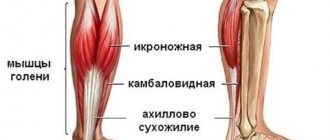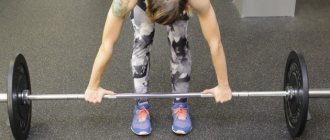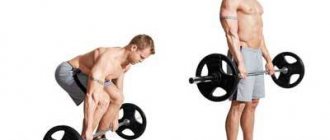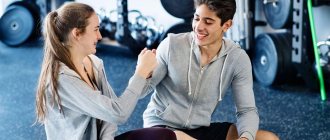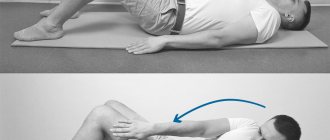Not everyone can devote extra time and money to visiting the gym, but everyone wants to have a healthy back, beautiful posture and elastic muscles. Not only classes in a fitness club, but also simple exercises at home can help you achieve beautiful shapes and a slender body. One of these exercises that can be performed even at home is hyperextension, which is aimed at developing, first of all, the back muscles, and does not require machines or dumbbells; all you need to do is your own body weight and determination!
- Hyperextension: the purpose of the exercise
- Benefits of Hyperextension
- Technique for performing hyperextension at home
- Video instructions for the hyperextension exercise
- Reverse hyperextension to perform at home
- “Boat” or hyperextension with simultaneous raising of arms and legs
- Video: boat exercise technique
- Hyperextension on a fitball
- Direct hyperextension on a fitball
- Video: hyperextension on a fitball
- Reverse hyperextension on a fitball
- Video tutorial on performing reverse hyperextension on a fitball:
- Lateral hyperextension on a fitball
- Practical tips for performing hyperextension
Hyperextension: the purpose of the exercise
The greatest load when performing hyperextension falls on the lower back - the extensor muscles that are connected to the spine. In addition to them, the hamstrings, semitendinosus and semimembranosus muscles of the thigh, as well as the calves and buttocks are activated during the work. Thus, hyperextension serves the following purposes:
- Strengthening the muscle corset (this maintains the tone and health of the back).
- Development of the gluteal, thigh and calf muscles (correction of their shapes and volumes).
- Preparing muscles to perform more complex, basic exercises.
- Supports overall muscle tone.
- Development of abdominal muscles, burning fat in the abdominal area (in some types of hyperextension).
Reverse variation for buttocks
Reverse hyperextension involves lifting your legs with your upper body fixed. In essence, reverse hyperextension is similar to leg swings, the most effective glute exercise. It develops the gluteus medius muscles, giving them their characteristic round shape.
The technique is simple - first the upper body is fixed, then both legs are slowly raised up. At the same time, it is easier for beginners to perform reverse hyperextension not with both legs at the same time, but with raising the legs alternately. A more complicated version - with a ball clamped between the ankles.
Harm and contraindications
Improper execution of hyperextensions is one of the common causes of pain in the lower back. Remember that the final point of the exercise should be a horizontal position (or an angle of 45 degrees when performed in a Roman chair) - excessive arching of the back back is dangerous and can injure the lower back. In addition, follow the rhythm of movement, perform the exercise smoothly and without jerking.
Contraindications to performing hyperextensions may include pain in the spine, especially in its lower part. It is necessary to understand what exactly provokes these pains. In some cases, hyperextension will be useful for strengthening muscles (it will help you do deadlifts correctly) - but if the cause of pain is damage to the spine, such an exercise can be harmful.
***
New Fitseven materials, 5 times a week - in telegram:
- fit7seven
Hyperextension (or trunk extension) is an exercise to strengthen the muscles of the lower back, lower back and gluteal muscles. To perform it, you can use either a special exercise machine or a fitball (useful at home). In turn, reverse hyperextension is an exercise for pumping up the buttocks and giving them a rounded shape.
Benefits of Hyperextension
The main advantage of hyperextension is the absence of strong load on the vertebrae at all stages of the exercise. A small range of flexion is enough to activate the back muscles. In addition, frequent hyperextension exercises relieve back and lumbar pain. As already noted, the exercise does not require special equipment or sports equipment. In addition to strengthening the spine, hyperextension affects the functioning of the tendons. If you work out at home without a barbell or dumbbell machine, a back curl session will prepare your body for weight training.
The purpose of performing hyperextension at home
The main goal is to train the extensors. At the same time, the athlete works the thigh biceps and buttocks. Proper exercise technique allows you to strengthen the muscle corset. The exercises are not aimed at increasing lean mass, but they create good support for the body due to painstaking work on the apparatus that supports the load.
Many athletes can easily tell you how hyperextension is performed in the gym. The fitness area is equipped with special complexes on which you can work lying down or in a semi-inclined position. Hyperextension at home is also practiced. Exercises are useful for the following categories of people:
- for beginner athletes, as they help prepare the back for full physical activity;
- people with spinal problems, as they harmonize the functioning of the spinal column and relieve discomfort when moving;
- persons with physical inactivity, since they help eliminate musculoskeletal disorders caused by low activity.
The exercises are recommended for everyone, regardless of age and level of athletic training. The complex is contraindicated for people with acute pain in the back and lumbar injuries.
Hyperextensions are exercises that are aimed primarily at working the muscles of the lower back, erector spinae and gluteal muscles. In addition, many stabilizer muscles of the abs, hips, and back will be worked, which will allow you to tone them. In addition, hyperextensions have a low risk of injury when performed and do not overload the joints, but this is subject to the correct execution technique.
For the most part, hyperextension at home or in the gym is of interest to people with back problems. Osteochondrosis, weak spine, scoliosis, pain in the lumbar region – these problems are largely what hyperextension is designed to solve. Because by strengthening the muscles located along the spine, you lighten the load on the spinal column, because strong muscles will take away part of the load that falls on our central axis.
However, hyperextension is a favorite exercise for our girls. The reason for this is the increased load on the buttocks.
We recommend reading: How to pump up your buttocks and is it possible to do this in a week, a month: how to squat correctly and what exercises should be done to pump up the gluteus maximus and minimus muscles
Frankly speaking, replacing hyperextensions at home without a machine is very problematic, since the exercise requires a Roman chair or a special machine. But let's try to get out of this difficult situation and figure out how to do hyperesthesia at home.
We decided to offer you hyperextensions that can be performed at home without a machine, as well as those that will require the help of a partner and a minimal set of equipment that many people have at their disposal. If you decide to go to the gym, then learn hyperextension exercises for the gym here.
Technique for performing hyperextension at home
The classic version of the exercise is performed in a lying position on the floor, bench, sofa or bed. Leg position: you can independently hold your feet flat or put a heavy object (bag, bar) on your ankles. If you have an assistant, ask him to hold your feet so that they do not leave the floor during the exercise. Next, follow the steps of the technique:
- Focus on the abdominal and thigh muscles, your feet should rest your toes on the floor.
- Stretch your arms at your sides or put them behind your head. You can also stretch your arms forward and spread them to the sides as you lift your body off the floor.
- As you exhale, lift your body, slowly arching your back.
- As you inhale, lower yourself to the starting position.
Number of approaches and repetitions: 3×10.
The correct technique for performing horizontal hyperextension while lying on the floor with emphasis on the hips.
The correct technique for performing horizontal hyperextension while lying on the floor with emphasis on the hips
Video instructions for the hyperextension exercise
Hyperextension without a machine
If it is not possible to purchase special equipment, you can perform the hyperextension exercise on the floor. With proper technique, the muscles of the lower back, buttocks, hips and shoulders will be used. The overall effectiveness of the training will be slightly reduced due to the fact that the counterweight will not be used. It is worth increasing the number of approaches and repetitions.
Hyperextension on the floor: order of execution
- Lie on your stomach, straighten your legs so that your body forms a straight line.
- Place your hands behind your head, spread your elbows.
- Slowly raise your upper body, pressing your hips toward the floor.
- The gaze should be directed straight ahead, the neck in a neutral position.
- Stay at the highest point for 15-20 seconds and return to the starting position.
Perform at least three sets of 30-50 repetitions. You can stretch your arms straight out in front of you, or straighten them behind you.
Reverse hyperextension to perform at home
The target muscles of reverse hyperextension also include the back extensors, gluteus maximus, biceps femoris, and rectus abdominis. Feature of the exercise: in this case, bending is carried out not by the upper part of the body, but by the lower part, i.e., with the legs. To perform reverse hyperextension, use a stable support: chairs, table or bench. Below you will find explanatory photos and videos.
- Lie on a support so that the upper part of the body is supported, and the lower part is hanging freely, with your toes touching the floor.
- Grab the support with your hands and, as you exhale, begin to slowly raise your legs, working your back muscles.
- Try to reach the maximum point, then inhale and lower your hips to the starting position.
Number of approaches and repetitions: 3×12–15 times.
Stages of performing reverse hyperextension at home with emphasis on a table
If you do not find comfortable support, reverse hyperextension can also be performed from the floor. The starting position will be as follows: lie on your stomach, place your head on your crossed arms, bend your knees, and point your feet up. Lift your hips off the floor, fixing your upper body on the floor.
Hyperextension on a horizontal surface
To perform this exercise, you will need either chairs stacked together or stools. It can also be done on the couch. The execution technique will be as follows:
- Sit face down on the support so that only your thighs rest on it. The body should hang down freely, but the head should not touch the floor, and the legs should rest on the floor. Securely support your feet. If this is not possible, then ask someone to hold them for you.
- Inhale and lift your body so that your body forms a straight line with your legs. Stay in this position for a few seconds and, as you exhale, return back.
- The exercise should be done 10-15 times and complete 3 sets.
“Boat” or hyperextension with simultaneous raising of arms and legs
The well-known “boat” is one of the types of hyperextension; its technique combines elements of forward and reverse bending. The exercise is ideal for doing gymnastics and fitness at home. To perform the “boat” you will need a gymnastic mat or other soft but flat support.
Technique for performing a ball boat: correct placement of arms and legs
- Lie on your stomach, straighten your legs, stretch your arms above your head.
- As you exhale, use your abdominal muscles to bend your back and at the same time raise your arms and legs.
- Keep your head straight, do not spread your hands and feet to the sides.
- After passing the highest point, inhale and slowly return to the starting position.
Number of approaches: 3.
Number of repetitions: 12–15.
Video: boat exercise technique
Types of exercises in the gym and at home
- Classic. It is carried out using all kinds of simulators.
- At an angle. Using the so-called “Roman chair”.
- On fitball.
All of the above applies more in the gym.
Methods for home training
At home, hyperextension is done in other ways, and there are three in total.
- First. Using a bed, stools that are lined up. A surface that is too soft is undesirable, as is one that is too low. In the latter case, so that the athlete’s body hangs freely and the person does not hit his forehead on the floor surface. Here, of course, an assistant who will reliably fix the legs of the training person will not hurt. In addition, a partner is an additional incentive to train, since together things will be more fun, and having a team, even such a small one, and a sense of comradeship, do their good work.
The starting position will be lying on the stomach, face down, where the athlete’s legs and body are a straight line.
- Second. The main advantage of hyperextension at home, lying on the floor, is that practically nothing additional is required for this - no equipment or devices. Here you can even fix your legs, say, under a radiator, sofa, chair or closet - this is in the absence of a partner.
Inhaling, you need to smoothly raise your head, lifting your torso off the floor with your back arched. In the upper phase of the exercise, a two-second fixation is performed, followed by the same smooth return to the starting position. Three sets of 15 repetitions are done.
- The third method involves the presence of a gymnastic ball called a fitball. In the starting position, the ball is placed in front of the athlete. The stomach and upper pelvis lie on the ball, legs are straightened, and the foot is resting against a wall or other vertical surface. The body and legs are a straight line, and the back is slightly arched. The torso lowers down until it feels like the hamstring muscles are stretched to their maximum. This is followed by a return to the starting position by tensing the lower back muscles. 3 sets of 15 repetitions.
In the second method, you cannot lift your hips off the floor.
Hyperextension on a fitball
If you are the proud owner of a fitball, three more techniques for performing hyperextension are available to you: direct, reverse and lateral. The basis of the exercise remains the same as in classic hyperextension. With direct bending, the body is lifted with emphasis on the fitball, with reverse bending, the legs are lifted, and lateral bending is performed with emphasis on the lateral part of the thigh. Let's consider a step-by-step execution technique for each case:
Direct hyperextension on a fitball
Position of the body when performing hyperextension on a fitball
- Lie on your stomach on the exercise ball so that the main emphasis is on your lower abs and upper thighs.
- Place your feet firmly on the floor.
- Place your hands behind your head or cross them over your chest.
- Start making amplitude movements: lower and raise your body, bending at the lower back.
- Try to perform the exercise using the target muscles, eliminating mechanical inertia.
Number of approaches and repetitions: 3×12 times.
Video: hyperextension on a fitball
Reverse hyperextension on a fitball
Stages of the exercise: initial and peak position of the body
Stages of the exercise: initial and peak position of the body in space
- Lie on your stomach on the exercise ball so that your body is parallel to the floor.
- Place emphasis on both palms, bend your arms slightly at the elbows.
- As you inhale, begin to slowly raise your legs, tensing your abdominal muscles.
- Then lower them to the starting position.
Number of approaches and repetitions: 3×12 times.
Reverse hyperextension on a fitball, in addition to the main target muscles, makes the gluteal muscles actively work.
Video tutorial on performing reverse hyperextension on a fitball:
Lateral hyperextension on a fitball
To make the oblique abdominal muscles burn, perform lateral hyperextension:
- Lie on the side of your thigh with the support on the exercise ball.
- Place your hands behind your head, rest your feet on the floor.
- Start doing god curls.
- On inhalation - body up, on exhalation - down.
Number of sets and reps: 3x10 on each side.
Peak body position when performing lateral hyperextension on a fitball
Practical tips for performing hyperextension
When performing various variations of hyperextension, adhere to the following rules, which will allow you to hone your execution technique and increase the effectiveness of your training:
- Don't lower your body too low.
- Do not lift your body high (there should be no pain in the spine).
- Do not swing, do not do the exercise inertia. Try to control every movement.
- Perform lifting and lowering slowly and with concentration.
- Do not bend your knees; the body should be “tight”.
- Do not use additional weights in the exercise (you can increase the load only after gaining significant experience in performing hyperextensions).
- If you have diseases associated with impaired functioning of the muscles of the lower back and back, contact a specialist and find out whether this exercise can be performed in your case.
Hyperextension is suitable for men and women of all ages. It is used not only as a training element to create a beautiful, strong back, but also as a general prevention of various diseases of the joints and muscles. To make the exercise as effective and safe as possible for yourself, it is important to follow the rules for its implementation: to do this, try to study the technique of compound movements theoretically and practically. Be sure to include forward and reverse hyperextensions in your warm-up workout. This will prepare your muscles for more difficult exercises and eliminate the possibility of mechanical injury.
Hyperextension for low back pain. Execution technique
Hyperextension is unique in that it simultaneously strengthens the most important muscles, which in modern humans, as a rule, are greatly weakened: the lumbar and gluteal muscles.
Contrary to common fears, the exercise is not dangerous for the lower back, quite the opposite. Hyperextensions can be called a safe alternative to deadlifts, but it is important to follow a number of rules.
— Make slow, controlled movements, do not swing your body, breathe correctly (exhale when you try to force it). There is no need to swing your body, even if you are doing the exercise on a machine - a special bench for hyperextension.
— Do not bend your lower back when lifting, just up to the straight line of your body.
— Do not use additional weights (for example, when performing hyperextension, it is customary to pick up a dumbbell). Better do more slow repetitions. You can increase the load by placing your hands on the back of your head or placing your palms on your forehead.
The benefits of hyperextension
Strengthens the gluteal muscles, lower back, hip extensors (muscles of the back of the thigh). Hyperextension helps increase the strength of the back extensors, stretches well and at the same time strengthens the lumbar spine. At the same time, it engages the trapezius muscles in the upper part of the spine and the muscles of the back of the neck, which are also very important to strengthen, since the neck is tense when we work at the computer, drive a car, or bend over a smartphone.
Hyperextension is especially useful for those who lead a sedentary lifestyle; it serves to prevent back pain and poor posture. It is used for osteochondrosis of the spine with disc herniation, and for hyperlordosis of the spine - excessive curvature of the lower back.
Hyperextension at home
Analogues of exercises on a simulator are hyperextension on a fitball or just lying on the floor - a boat. When performing hyperextension on a fitball, additional work is done on the core muscles (deep skeletal muscles), since you have to maintain the balance of the body.
Hyperextension lying on the floor (boat)
I.P. Lie on your stomach, hands on the back of your head or extended forward. Legs straight. We try to lift the body off the floor without straining the buttocks. We bring our shoulder blades together and straighten our chest. Try to raise your body low, your head looking at the floor, exhale as you rise. You need to perform 3 approaches 15-25 times each.
A complicated version of the “boat” : “swim”, that is, having raised ourselves, we make energetic oscillatory movements with our arms and legs.
Pain in the back and joints. Movement therapy
If you have problems with your back and joints, then before starting independent exercises, it is advisable to undergo at least one course of therapeutic exercises under the guidance of a trainer who will set the correct technique and teach you how to breathe correctly. Then you can safely do the exercises at home.
The Kazan Kinesitherapy Center conducts classes on special rehabilitation equipment - kinesiosimulators, which are aimed at treating diseases of the spine and joints: protrusions, hernias, spondyloarthrosis, osteoarthritis and arthritis of the joints, correction of postural disorders (stooping, scoliosis, hyperlordosis).
Modern, effective, safe methods without drugs or surgeries, which are aimed at solving several important problems at once:
– relief of muscle spasms, inflammation of periarticular muscles – a source of pain and discomfort,
– restoration of the balance of weakened and tense muscles, skeletal muscle functions,
— restoration of nutrition of the diseased disc or articular cartilage (lymph drainage, blood supply, innervation) by activating deep skeletal muscles, which triggers the natural mechanisms of regeneration of osteochondral tissue.
- formation and strengthening of the muscle corset, which supports and nourishes the spine, joints,
- formation of new correct biomechanics of movement, as an important condition for preventing relapse of pain and disease in the future.
The exercise program is compiled individually after a comprehensive diagnosis of the musculoskeletal system using the applied kinesiology method.
Specialist consultation is required.
Doctor’s consultation + diagnostics using applied kinesiology – 1000 rubles.
Call, write! Tel.: (843) 570-55-25 , WhatsApp: 79655968085 or VKontakte group .
Read us on Yandex Zen:
Follow us on Instagram:
Don't miss out on the fun! Subscribe to our news:
Subscribe to news from the Kazan Kinesitherapy Center
Center promotions, therapeutic exercises and useful tips from our specialists on how to independently maintain the health of your joints and spine without medications
Similar articles:
Summer prices for kinesitherapy courses
Therapeutic yoga for the spine and joints. We invite you to a free lesson
Shortened hamstrings as a cause of knee and lower back pain. Safe kinesiology exercise...

